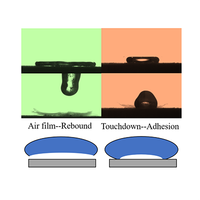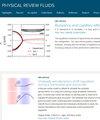干冰表面反莱顿弗罗斯特液滴的反弹动力学
IF 2.5
3区 物理与天体物理
Q2 PHYSICS, FLUIDS & PLASMAS
引用次数: 0
摘要
在本文中,我们通过实验研究了干冰表面水滴的反弹动力学,揭示了反向莱顿弗罗斯特现象背后的机理。我们证明,驱动反向莱顿弗罗斯特现象的根本机制是干冰升华时产生的气膜的升力。空气膜可防止液滴凝结,促进液滴反弹。不过,气膜的存在很大程度上取决于冲击条件。在早期扩散阶段,由于升华,气泡在接触线处成核,然后气泡长大并逐渐形成气膜。我们的研究表明,只有当气膜在最大扩展阶段之前完全形成时,液滴才会反弹。否则,接触线就会冻结,最终阻碍液滴反弹。我们提出了决定液滴是否反弹的临界气膜厚度的理论表达式。根据该表达式,我们最终通过热力学和流体动力学原理建立了液滴反弹的理论标准。为了验证我们建立的理论标准,我们进一步研究了不同流体、韦伯数字和不同温度液滴的逆莱顿弗罗斯特现象。结果表明,我们理论标准的预测结果与实验结果高度一致。本文章由计算机程序翻译,如有差异,请以英文原文为准。

Rebound dynamics of inverse Leidenfrost droplets on dry ice surfaces
In this paper, we experimentally investigate the rebound dynamics of droplets on dry ice surfaces, unveiling the mechanism behind the inverse Leidenfrost phenomenon. We demonstrated that the underlying mechanism driving the inverse Leidenfrost phenomenon is the lift force from the air film generated by the sublimation of dry ice. The air film prevents droplet condensation, facilitating the droplet rebound. However, the presence of film significantly depends on impact conditions. During the early spreading stage, bubbles nucleate at the contact line due to the sublimation, then the bubbles grow and gradually form an air film. We showed that the droplet rebound occurs only when the air film fully forms before the maximum spreading stage. Otherwise, the contact line is frozen, ultimately preventing rebound. We propose a theoretical expression of critical air film thickness that determines whether the droplet rebounds. Based on the expression, we ultimately established a theoretical criterion for droplet rebound via thermodynamic and fluid dynamics principles. To validate our developed theoretical criterion, we further investigated the inverse Leidenfrost phenomenon for different fluids, Weber numbers, and different temperatures of droplets. The results demonstrate a high consistency between the predicted results of our theoretical criterion and experimental results.
求助全文
通过发布文献求助,成功后即可免费获取论文全文。
去求助
来源期刊

Physical Review Fluids
Chemical Engineering-Fluid Flow and Transfer Processes
CiteScore
5.10
自引率
11.10%
发文量
488
期刊介绍:
Physical Review Fluids is APS’s newest online-only journal dedicated to publishing innovative research that will significantly advance the fundamental understanding of fluid dynamics. Physical Review Fluids expands the scope of the APS journals to include additional areas of fluid dynamics research, complements the existing Physical Review collection, and maintains the same quality and reputation that authors and subscribers expect from APS. The journal is published with the endorsement of the APS Division of Fluid Dynamics.
 求助内容:
求助内容: 应助结果提醒方式:
应助结果提醒方式:


